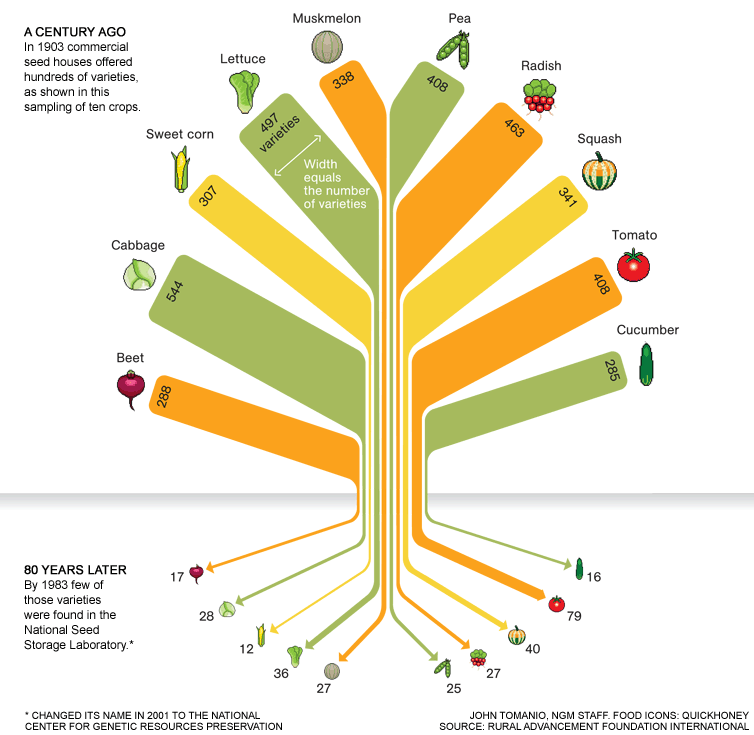Aiming for food sovereignty
Seeds as a contributor in securing our food future
Saving, growing, and sharing seeds contribute to securing the sustainability of our food future and stand as a powerful catalyst to curb world hunger. Being the initiator of the food production process, saving seeds allows us to have more control over our food supply while building strong resiliency in our garden and in others’. Producing our own seeds also help to save money, as there is no dependence on external sources such as retail seed companies to get seeds.
Preserving cultural heritage and genetic diversity
Seeds as a living tie to our history
Seed saving is a powerful catalyst to help us to connect with our ancestors and past generations of seed savers, while preserving the history, cultural traditions, and knowledge surrounding the heirloom seeds that were carefully selected and passed on by them. Those are a critical bridge to this heritage and its continuity.
Plant biodiversity is disappearing at an alarming rate. Over the course of 80 years (between 1903 and 1983), 93 percent of our native food crop varieties were lost. We went from 497 varieties of lettuce to 36, 288 varieties of beets to 17, and 307 varieties of sweet corn to 12. Tomato varieties are particularly impacted, having lost at least 80 percent of their diversity over the last century. Many of these plants have been and are being replaced by patented genetically engineered (GE) varieties created by global agrotech and biotechnology companies such as Bayer-Monsanto, DowDuPont/Corteva and ChemChina-Syngenta.

Living closer to Nature and her lifecycle
Seeds as a teacher of Life
Being able to observe plants through seed production is a great opportunity to maintain and nourish the cycle of life. Even the common gardener does not always get the chance to experience the full lifecycle of what they are growing, as most leafy greens are for instance consumed before they flower and set seed. Careful observation leads to a better understanding of each plant characteristics, needs, and growing patterns through the seasons. It allows one to slow down, being more in tune with Nature, and cultivate appreciation for her unconditional abundance.
Adapting plants to local environment in an era of climate change
Seeds as a tool to build environmental awareness and restore land
Saving seeds leads to a gradual adaptation of the planted varieties to the soil, climate, and the specificities of the local growing conditions. A conscientious seed selection from those varieties will give plants that are better equipped to develop an increased resistance to pests, diseases, and a capacity to withstand regional climatic changes and hazards over time. Seeds then hold the potential to help in the regeneration and restoration of previously damaged ecosystems and lands.
Producing more nutritious and flavorful food
Seeds as a way to live a healthier life
Saving seeds allows a better control of the plant population’s gene pool through an optimal selection based on specific traits such as flavor. Over the years, this process will help to build a better, healthier, and more consistent food quality by exposing one to a broader range of nutrients and varied food choices. Seeds are also a great catalyst to reconnect with traditional cooking by offering an opportunity to honor, share, and safeguard the uniqueness of the food heritage of our own ancestors and region.
Helping pollinators
Seeds as a means to protect bees
Bees are one of the main insect pollinators involved in the pollination and reproduction of most of the vegetables and fruits on which humans rely. As seed savers, the rapid and critical decline of their population observed in the past few years calls for initiatives that will ensure their survival. Growing crops for seed production in an environment that is conducive to pollination will provide invaluable food for bees and the survival of their habitat. Building beehives specifically made with that purpose in mind is a great tool to further protect them.
Building community
Seeds as a path to build shared resiliency
Sharing is an inherent, historical component of seed saving. There simply cannot be seed saving without sharing, as there cannot be sharing without seed saving. Most of the seed savers if not all are community driven, thriving to actively give and exchange seeds within different networks, groups and movements. Through the creation of community gardens and seed banks, the preservation of their respective food crop heritage is ensured, while the quality of their seeds is improved when replanted and saved again through selection.
Reclaiming our rights
Seeds as a political statement against the corporate control of food
The consolidation of the agrochemical companies and the domination of GE seeds in commodity crops have made it increasingly difficult for farmers to access and purchase non-GE seeds. The advent of genetic engineering has expedited claims for seed patents and subsequently has become a gateway to controlling seed germplasm writ large. Today, protecting and defending our right to be in charge of our own food, to freely access, grow, and save seeds, as well as to breed plants for new varieties is more crucial than ever. Seed savers hold the responsibility to sow the seeds of resistance by keeping this common good open, decentralized, and alive for all human beings.
